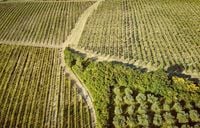Sicily has emerged as the leading region in Italy for vineyard area, boasting over 118,000 hectares, which accounts for 17.8% of the national total. Following closely is Veneto, with 95,000 hectares, representing 14.2% of the total vineyard area. However, Veneto takes the crown for wine production, having produced a remarkable 10.7 million hectoliters in 2024, which is 22.3% of Italy's total wine output. This information was presented in a report by Censis and Confcooperative titled “L’Italia del vino: superfici, costi ed export” at the Vinitaly event.
In terms of wine production, Italy saw a national increase of 12.9% in 2024, bringing the total to 48 million hectoliters. Yet, a closer look reveals a downward trend from 2019 to 2024, with total production decreasing by 3.7%. This decline affected all wine types except for white DOP (Denominazione di Origine Protetta) and IGP (Indicazione Geografica Protetta) wines, which have remained stable.
Puglia, another significant player in the wine industry, has 93,000 hectares of vineyards, which is 14.0% of the national total. Emilia-Romagna follows with approximately 50,000 hectares, preceded by Tuscany with 53,000 hectares, accounting for 7.9% of vineyard area. Notably, Friuli-Venezia Giulia stands out with the highest ratio of vineyard area to total surface area, with 10.4 hectares per 100, compared to the national average of 4.2 hectares per 100.
Overall, Italy has a total of 693,000 hectares dedicated to vineyards, which represents an increase of 3.4% from 2019 to 2024. The geographical distribution of these vineyards shows that hills dominate, comprising 55.5% of the agricultural surface. Plains account for 39.2%, while mountainous areas make up the remaining 5.3%.
While Veneto leads in overall production, it is important to highlight that the region has shown consistent positive production variations, both from 2023 to 2024 (+0.6%) and from 2019 to 2024 (+3.8%). Puglia and Emilia-Romagna have also experienced positive production phases recently, with these three regions collectively contributing to more than half of Italy's wine production.
Breaking down the numbers, Veneto produced 10,686,948 hectoliters in 2024, followed by Puglia with 8,054,700 hectoliters and Emilia-Romagna with 6,903,977 hectoliters. Sicily contributed 4,229,568 hectoliters, while Abruzzo, Tuscany, and Piemonte produced 3,181,450, 2,722,025, and 2,172,692 hectoliters respectively.
When examining the production per hectare, Emilia-Romagna leads with 137.6 hectoliters per hectare, surpassing Veneto's 113 hectoliters per hectare. In contrast, regions with a rich winemaking tradition, such as Piemonte (55.2), Tuscany (51.6), and Sicily (35.8), lag significantly behind.
The leadership of Veneto is particularly evident in the contributions from its provinces. Treviso and Verona are the top producers, with Treviso generating 5.2 million hectoliters and Verona 2.6 million hectoliters in 2024. Among the top ten provinces for wine production in Italy, four are located in the North East, including Ravenna (2.9 million hectoliters) and Reggio Emilia (1.4 million hectoliters). Collectively, these top ten provinces account for 51.1% of Italy's total wine production.
In the realm of DOP wines, Treviso and Verona again lead the pack, producing nearly 4 million and just under 2 million hectoliters, respectively. Agrigento, located in Southern Italy, ranks third with 1.1 million hectoliters of DOP wine. Overall, the top ten provinces contribute over 56% of Italy's DOP wine production, which amounts to just under 22 million hectoliters.
Taranto emerges as the leading province for IGP wine production, generating 1.6 million hectoliters, followed by Treviso (1.1 million hectoliters) and Ravenna (877,000 hectoliters). The top ten provinces for IGP wines also account for over half of the total IGP production in Italy, which stands at 14 million hectoliters, representing 57.0%.
A notable statistic reveals that Cerignola in Foggia holds the title for the largest vineyard area, with an impressive 12,000 hectares dedicated to grape cultivation. Among the top ten municipalities for vineyard area, six are located in Sicily, including Mazara del Vallo, Marsala, Alcamo, Salemi, Trapani, and Monreale.
In terms of quality wine production, Castellina in Chianti (Siena) is distinguished for its dedication to DOP wines, with 76.2% of its vineyard area allocated for this purpose. It is followed closely by San Gimignano and Manduria, with 75.5% and 74.4% respectively. Other notable DOP-focused municipalities include Montespertoli (73.6%), Montalcino (70.2%), and Montepulciano (69.8%), all situated in Tuscany. Additionally, four Sicilian municipalities—Marsala, Mazara, Trapani, and Menfi—have DOP surface areas ranging from 55.9% to 61.1%. This comprehensive overview highlights the diverse and rich landscape of Italy's wine production, showcasing both the challenges and successes faced by the industry.




